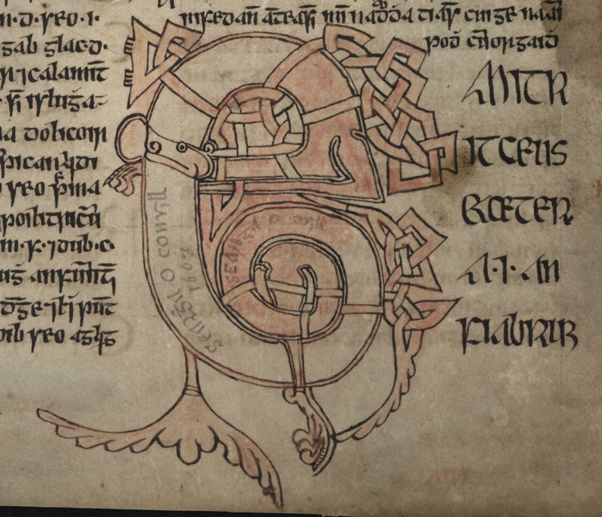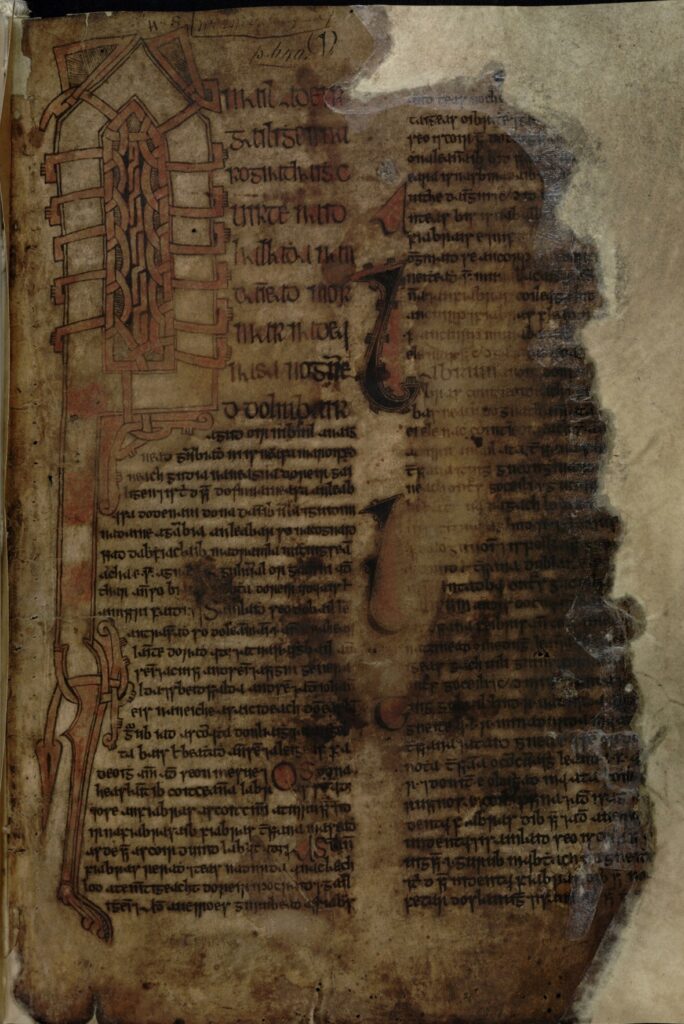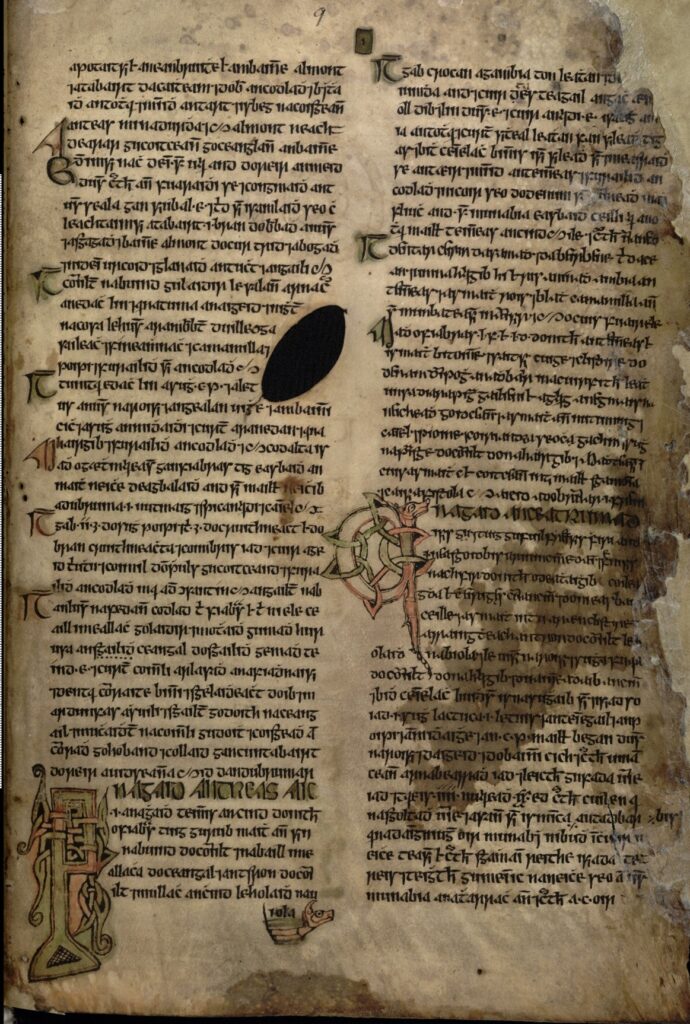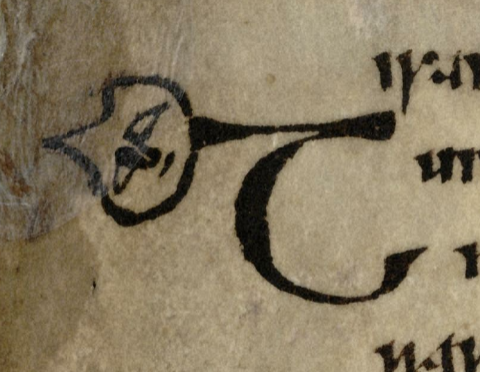Dublin, Royal Irish Academy MS 23 P 10 iii (456)
Siobhán Barrett

Figure 1: Dublin, Royal Irish Academy MS 23 P 10 iii, p. 47: a zoomorphic initial letter ‘e’ incorporating the name of Seargha O Conuill, twice, and the year 1663 (image courtesy of Irish Script on Screen).
This is a vellum manuscript with large pages measuring 14″ x 10″ (approx 35cm x 25cm). The margins of pp. 1–4 and of pp. 19–25 have been badly damaged, resulting in significant loss of text. According to Wulff (1932), ‘(Eugene) O’Curry suspects it had been chewed by some animal (a rat?)’. The cataloguer suggests that this manuscript is from the fifteenth century. There is no scribal signature but the name Seargha O Conuill is found on p. 45 and again on p. 47 (Figure 1 above), along with the year 1663. O’Curry also suggested that the language in the manuscript is from Co. Clare. The name of a barony in Co. Clare, Corcumruadh (Corcomroe), is included as the location where a particular plant for treating linn dubh ‘melancholic humour’ can be found, namely filipendula a Corcumruadh. This plant is probably ‘dropwort’ and interestingly, according to Devlin (2014, 50), it is only found in the counties of Clare and the south-west part of Galway, i.e. the Burren.
The material in this manuscript appears to be a compilation drawn from different sources. This is typical of medical manuscripts and in this source the overarching theme is that of fevers. The compiler has taken excerpts from at least three authors, with a strong emphasis on the first book of John of Gaddesden’s Rosa Anglica, which deals solely with fevers. There are also references to the Compendium Medicinae by Gilbertus Anglicus and to Bernard of Gordon’s Lilium Medicinae. The first page of the manuscript contains the preface to the Rosa Anglica followed by discussion on fiabras tersiana ‘tertian fever’. This corresponds with the Irish translation of Rosa Anglica, based on the text found in RIA MS 23 P 20, which was edited by Winifred Wulff (1923, 1–17). Another chapter called De febrium symptomatibus, found on pp. 8–30 of this manuscript, is an Irish translation of another chapter of the Rosa Anglica and this was also edited by Wulff (1932). Two long chapters in this manuscript that are not included in the edited Irish translation of Rosa Anglica are An fiabras renabar coidiana (p. 31), a text on quotidian fever; and An fiabras renabar quartana, a text on quartan fever (p. 54).

Figure 2: Dublin, Royal Irish Academy MS 23 P 10 iii, p. 1: the preface and first chapter of the Irish Rosa Anglica (image courtesy of Irish Script on Screen).
Many Irish medical manuscripts are relatively unadorned, but this one is exceptional, having at least some illumination on almost all of its 70 pages. On the first page alone, though stained and partially eaten, there is an illuminated, headless, zoomorphic ribbon initial letter ‘a’, with a paw and tail, occupying the entire left margin. On the second column there are two large letters ‘l’, one measuring the length of 9 lines of text. The first line of text is in a larger script with red shading and there are several other large decorative initial letters. Elsewhere in the manuscript there are other fantastic dog-like beasts, along with two-headed and four-headed conjoined dogs at the ends of pages. These decorative features are typical of those found in the earlier Irish manuscript tradition.

Figure 3: Dublin, Royal Irish Academy MS 23 P 10 iii, p. 9. This page has about 13 decorative features with red and green colouring: a geometric letter ‘a’ combining ribbon design with interlacing; a ‘turn-in-the-path’ at the bottom of the first column indicating that the letters ‘iola’ are a continuation of the text above (le holaidh na viola); a zoomorphic letter ‘a’ featuring a dog’s head in the second column; and ten large rubricated initials (image courtesy of Irish Script on Screen).

Figure 4: Dublin, Royal Irish Academy MS 23 P 10 iii, p. 56: a sad-looking anthropomorphic letter ‘t’.
Further Reading:
Demaitre, Luke (1980), Doctor Bernard de Gordon: Professor and Practitioner (Toronto: Pontifical Institute of Mediaeval Studies)
Devlin, Zoë (2014), The Wildflowers of Ireland: A Field Guide (Cork: The Collins Press)